Biography
(No Information)
Filmography
all 3
Movies 3
self 3
Self (archive footage)

The History in the Gaze (2011)
Movie
Information
Known ForActing
GenderMale
Birthday1873-10-30
Deathday1913-02-22 (39 years old)
Birth PlaceParras de la Fuente, Mexico
FatherFrancisco Madero Hernández
SiblingsJulio Madero, Raúl Madero, Gustavo A. Madero, Emilio Madero González, Emilio Madero, Gabriel J. Madero, Evaristo E. Madero
CitizenshipsMexico
ResidencesCoahuila, Mexico
This article uses material from Wikipedia.
Last updated:
 Francisco I. Madero
Francisco I. Madero- Filmography
- Information

